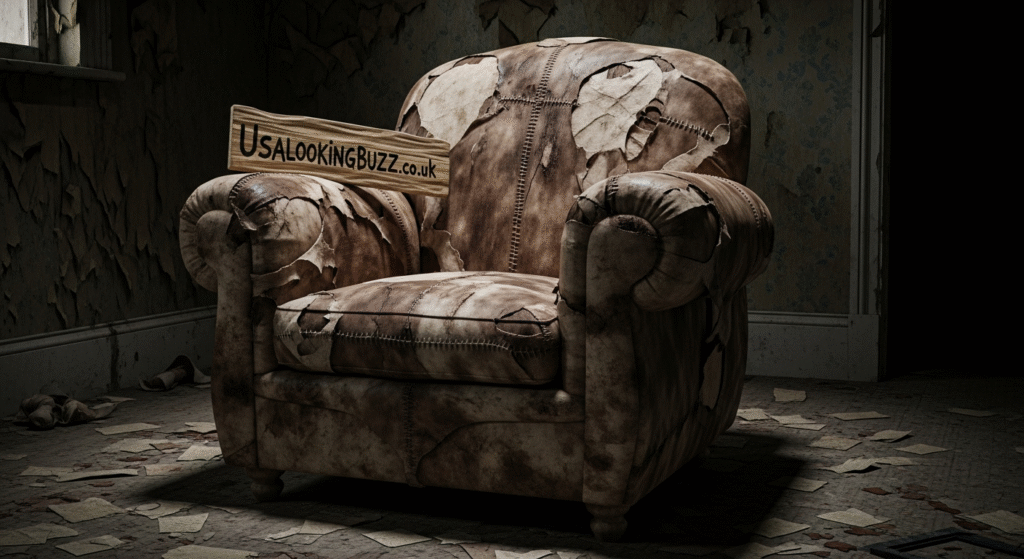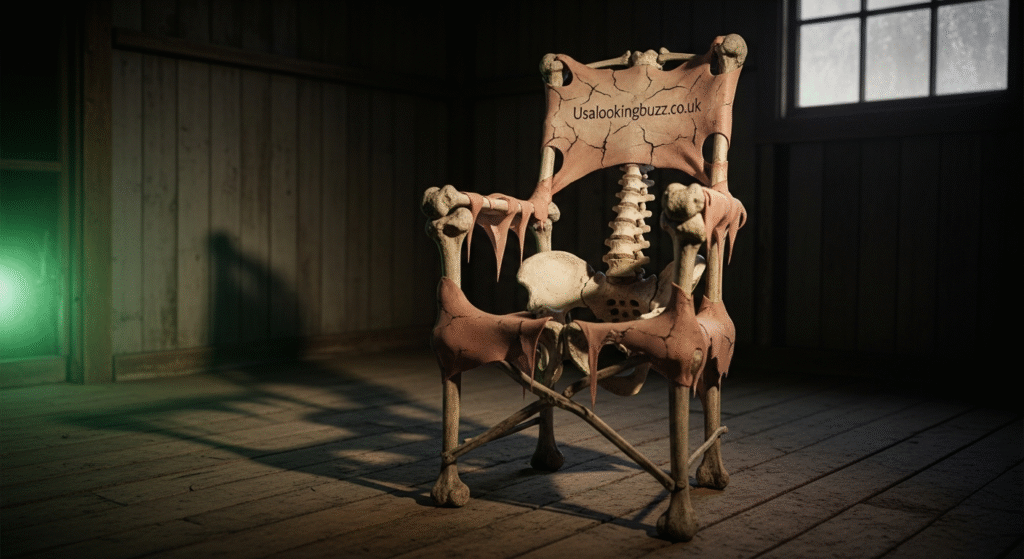Ed Gein Chair: Disturbing Truth Behind the Artifacts

Introduction
You’ve probably heard whispers about Ed Gein and the horrifying things investigators found in his Wisconsin farmhouse in 1957. Among the most disturbing discoveries was furniture crafted from human remains, including chairs upholstered with actual human skin. The Ed Gein chair has become one of the most infamous artifacts in true crime history.
When police entered Gein’s property on that cold November day, they encountered a scene that defied imagination. What they initially thought was a strange decorating choice turned out to be something far more sinister. The chairs, lampshades, and other household items weren’t just unusual. They were made from his victims.
I’ve researched countless true crime cases over the years, but few match the visceral horror of what authorities discovered in that Plainfield, Wisconsin home. The Ed Gein chair and similar artifacts represented more than just evidence of crimes. They revealed the depths of human depravity and mental illness.
This article explores the reality behind the Ed Gein chair, separating fact from fiction. You’ll learn what investigators actually found, how these items were created, their current whereabouts, and the lasting cultural impact of these disturbing artifacts.
Who Was Ed Gein?
Early Life and Background
Edward Theodore Gein was born on August 27, 1906, in La Crosse, Wisconsin. His childhood was marked by an oppressive, religiously fanatical mother and an alcoholic father. Augusta Gein dominated the household with strict religious teachings and isolated her sons from the outside world.
The family moved to a remote farm near Plainfield, Wisconsin, when Ed was young. This isolation intensified under his mother’s control. She taught her sons that women were inherently sinful and evil, with the exception of herself. This twisted worldview would profoundly shape Ed’s psychology.
Ed’s father George died in 1940, followed by his brother Henry in 1944 under suspicious circumstances. When Augusta suffered a stroke in 1945, Ed became her primary caretaker. Her death later that year devastated him. He sealed off her bedroom and living room, preserving them exactly as she left them.
After his mother’s death, Ed lived alone on the isolated farm. He took odd jobs around Plainfield and was generally regarded as strange but harmless. Neighbors found him eccentric and socially awkward, but nobody suspected the horrors taking place inside his home.
The Crimes That Shocked America
Ed Gein’s crimes came to light on November 16, 1957, when hardware store owner Bernice Worden disappeared. Her son, a deputy sheriff, suspected Gein based on a sales receipt. When authorities arrived at Gein’s farmhouse, they made discoveries that would horrify the nation.
Police found Bernice Worden’s decapitated body hanging in a shed, dressed like a deer carcass. This grisly scene was just the beginning. Inside the house, investigators discovered items that would haunt them for the rest of their lives.
Gein confessed to killing two women: Bernice Worden and tavern owner Mary Hogan, who disappeared in 1954. However, the human remains found on his property came from many more bodies. Gein admitted to robbing graves, exhuming recently buried corpses from local cemeteries.
He targeted graves of middle-aged women who resembled his mother. Between 1947 and 1952, he made nocturnal visits to three local cemeteries. He would dig up bodies, take them home, and use them for his gruesome projects. Gein claimed he entered dissociative states during these activities, sometimes not remembering his actions.
The Horrifying Discovery
What Police Found in the Farmhouse
The inventory of items found in Ed Gein’s home reads like something from a horror novel, yet it was devastatingly real. The Ed Gein chair was among numerous furniture pieces and household items crafted from human remains.
Investigators documented chairs with seats woven from human skin. The flesh had been tanned and treated to preserve it, creating a grotesque upholstery. Multiple chairs throughout the house featured this horrifying modification. Gein had carefully removed skin from corpses and fashioned it into functional furniture components.
Beyond chairs, police found:
- Lampshades covered with human skin
- Bowls made from human skulls
- A wastebasket made from human skin
- Masks created from preserved human faces
- A belt made from human nipples
- Leggings fashioned from human leg skin
- A corset made from a female torso
The house contained preserved body parts stored in various locations. Heads were found in bags. Organs were kept in the refrigerator. A shoebox held vulvas that Gein had preserved. The bedroom contained a “woman suit” made entirely from human skin that Gein would wear.
The Condition and Preservation
What made the Ed Gein chair and other artifacts particularly disturbing was the care taken in their creation. Gein hadn’t simply attached raw flesh to furniture. He had learned rudimentary tanning and preservation techniques.
The skin used for upholstery had been treated to prevent decomposition. Gein used salt, various chemicals, and drying techniques to preserve the material. The result was leather-like material that could withstand regular use. This suggested planning and technical knowledge rather than impulsive acts.
Investigators noted that some items showed significant wear, indicating Gein had used them regularly for years. The Ed Gein chair wasn’t a recent creation or a single aberrant act. These items represented years of collecting, crafting, and daily living with his macabre creations.
The preservation quality varied across different items. Some pieces remained remarkably intact, while others showed deterioration. This variation suggested different time periods of creation and possibly different preservation methods as Gein refined his techniques.

The Psychology Behind the Artifacts
Understanding Gein’s Motivations
Ed Gein’s creation of furniture from human remains stemmed from complex psychological issues rooted in his relationship with his mother. After Augusta’s death, he became obsessed with recreating her and other women who resembled her.
Psychiatrists who examined Gein diagnosed him with schizophrenia. He experienced delusions and possibly believed he was bringing his mother back through his creations. The Ed Gein chair and other items weren’t trophies in the traditional serial killer sense. They served a different psychological purpose.
Gein reported feeling compelled to visit graves during full moons. He described powerful urges he couldn’t resist. His grave robbing and body modifications occurred during dissociative episodes where he felt disconnected from reality. He sometimes found himself in cemeteries without remembering how he got there.
The “woman suit” made from skin revealed Gein’s desire to literally become a woman, specifically his mother. He would wear this suit and dance around the farmhouse. The chairs and other household items surrounded him with female presence, perhaps attempting to recreate his mother’s domination of the home.
Mental Illness Versus Evil
The Ed Gein case raises difficult questions about mental illness and criminal responsibility. Gein was found legally insane and unfit to stand trial initially. He spent the rest of his life in mental institutions rather than prison.
His actions were undeniably evil and caused immeasurable suffering. Yet his severe mental illness significantly impaired his understanding of reality. Gein genuinely seemed confused about why his actions were wrong. He spoke matter-of-factly about his creations without apparent remorse or understanding of their horror.
This doesn’t excuse his crimes or diminish the tragedy of his victims. However, it highlights the complex relationship between severe mental illness and criminal behavior. The Ed Gein chair represents both evidence of horrible crimes and manifestation of profound psychological disturbance.
Modern forensic psychology students still study Gein’s case. His psychological profile influenced understanding of certain types of killers and body modification behaviors. The case contributed to development of criminal profiling techniques used by the FBI.
What Happened to the Ed Gein Chair
Evidence and Investigation
All items found in Ed Gein’s home, including the infamous chair, became evidence in his case. Authorities photographed and cataloged everything before removing it from the property. These photographs remain some of the most disturbing crime scene images in American history.
The Ed Gein chair and other artifacts were stored as evidence during the legal proceedings. Given Gein’s mental state, the trial focused on his competency rather than guilt. He was committed to Central State Hospital in Waupun, Wisconsin, in 1958.
In 1968, after years of treatment, Gein was found competent to stand trial. He was tried for the murder of Bernice Worden and found guilty but legally insane. The court recommitted him to the mental hospital, where he remained until his death from respiratory failure in 1984.
During this period, the physical evidence including the chair remained in storage. The items weren’t needed for ongoing trials since Gein’s guilt and mental state were established. Questions arose about what should be done with these horrifying artifacts.
The Auction and Public Reaction
In March 1958, authorities announced plans to auction Ed Gein’s personal belongings to settle debts against his estate. This sparked immediate and intense controversy. The idea of someone purchasing the Ed Gein chair or other items horrified many people.
Citizens of Plainfield were particularly outraged. They worried the auction would turn their town into a macabre tourist destination. Community members feared people would display these items or create ghoulish exhibitions. The town wanted to move past the horror, not memorialize it.
A group of concerned citizens raised $760 to purchase the entire contents of Gein’s house before the public auction. Their intention was to destroy everything. On March 27, 1958, they held a massive bonfire and burned all of Gein’s belongings, including furniture, clothing, and household items.
The Ed Gein chair, along with the lampshades, masks, and other human remains artifacts, were consumed in this fire. Local residents gathered to watch the flames destroy these objects of horror. For Plainfield, the burning represented an attempt at closure and moving forward.
Current Whereabouts
The original Ed Gein chair no longer exists. It was destroyed in the 1958 bonfire along with virtually all physical evidence from his home. Only photographs and official documentation preserve evidence of these items.
Some people claim artifacts survived the burning or that items were secretly preserved. These claims lack credible evidence. Law enforcement and Plainfield residents were determined to destroy everything. The intense public scrutiny made secretly preserving items extremely difficult.
The photographs taken during the investigation remain in various archives. Crime scene photos showing the Ed Gein chair and other items occasionally surface in documentaries or true crime publications. These images are often censored or described rather than shown due to their disturbing nature.
Ed Gein’s preserved brain was kept for scientific study after his death. This is the only confirmed physical remains related to the case. The brain was stored at the University of Wisconsin but later mysteriously disappeared. Its current whereabouts remain unknown.
Cultural Impact and Legacy
Influence on Horror and Popular Culture
The Ed Gein case profoundly influenced American horror culture. The Ed Gein chair and other discoveries inspired countless books, movies, and television shows. Three of the most iconic horror characters draw directly from Gein’s crimes.
Norman Bates from Alfred Hitchcock’s “Psycho” (1960) was partially based on Ed Gein. The mother-obsessed killer who preserved her body and assumed her identity mirrors Gein’s psychology. Robert Bloch, who wrote the novel “Psycho,” lived in Wisconsin and followed the Gein case closely.
Leatherface from “The Texas Chain Saw Massacre” (1974) wears masks made from human skin, directly inspired by Gein’s face masks. The film’s depiction of a house filled with furniture and decorations made from bodies closely parallels what police found in Plainfield.
Buffalo Bill from “The Silence of the Lambs” (1991) creates a “woman suit” from victims’ skin, exactly as Gein did. Thomas Harris explicitly acknowledged Gein as inspiration for this character. The character’s psychological profile draws heavily from Gein’s case.
True Crime Fascination
The Ed Gein case marked a turning point in American awareness of serial killers and extreme crimes. Before Gein, most people couldn’t imagine such horrors occurring in quiet rural communities. His case shattered assumptions about where evil could exist.
True crime as a genre exploded partially due to the Gein case. The combination of gruesome details, psychological complexity, and small-town setting created a template still used today. Documentaries, podcasts, and books continue revisiting the case decades later.
The Ed Gein chair specifically captures public imagination because it represents the everyday made horrifying. Chairs are ordinary, comfortable, domestic objects. Learning one was upholstered with human skin transforms something familiar into nightmare fuel. This juxtaposition of normal and horrific fascinates people.
However, this fascination raises ethical questions. The victims and their families suffered tremendously. Does continued focus on these artifacts and crimes exploit that suffering? How do we balance historical documentation and psychological understanding with respect for victims?
Myths and Misconceptions
Separating Fact from Fiction
Popular culture has exaggerated and distorted many aspects of the Ed Gein case. Separating verified facts from sensationalized myths is important for understanding what actually happened.
Myth: Ed Gein killed dozens of people. Reality: He confessed to two murders. Most body parts came from grave robbing, not killing. While grave desecration is deeply disturbing, it’s important to distinguish between murder and corpse theft.
Myth: The Ed Gein chair was his “throne” where he sat regularly. Reality: Multiple chairs had human skin components. These were functional furniture pieces distributed throughout the house, not a single ceremonial item.
Myth: Gein was a cannibal. Reality: No evidence supports cannibalism. While organs were found in his refrigerator, nothing suggests he consumed them. This myth likely arose from confusion with other serial killers.
Myth: Gein’s entire house was made from human remains. Reality: While numerous disturbing items existed, most furniture was normal. Sensationalized accounts sometimes suggest the entire house was a house of horrors, but most items were ordinary household goods.
The Truth About Souvenirs and Artifacts
Contrary to persistent rumors, no authentic Ed Gein artifacts exist in private collections. Everything was destroyed in 1958. Items occasionally offered for sale as “authentic” Ed Gein artifacts are fraudulent.
Some people claim to own pieces of Gein’s car or items from his property. His 1949 Ford sedan was exhibited briefly before being destroyed in a 2000 fire. A few car parts may exist, but they’re not the human remains artifacts that capture public imagination.
Crime memorabilia dealers sometimes offer “Ed Gein” items. These are invariably fake or misrepresented. The actual Ed Gein chair and related artifacts were thoroughly destroyed. Anyone claiming otherwise is either mistaken or deliberately deceiving buyers.
Photographs and official documents represent the only authentic Gein materials available. These reside in law enforcement archives, museums, and historical collections. Access is typically restricted to researchers and serious scholars.
Ethical Considerations
Victim Remembrance
Discussions of the Ed Gein chair and case often overlook the victims at the center of these crimes. Bernice Worden was a 58-year-old hardware store owner and mother. Mary Hogan was a 51-year-old tavern keeper. Both were respected community members whose lives were violently stolen.
The bodies Gein exhumed from graves also represent victims. These women couldn’t rest peacefully. Their remains were violated and desecrated. Their families suffered additional trauma learning how their loved ones’ bodies were used.
When we focus on the shocking details of the Ed Gein chair and other artifacts, we risk losing sight of these human costs. These weren’t just materials for furniture. They were mothers, daughters, sisters, and friends. Their dignity was stolen along with their bodies.
Respectful coverage of true crime cases should balance public interest with victim dignity. We can study these cases to understand criminal psychology and improve public safety while maintaining respect for those who suffered.
The Dark Side of True Crime Tourism
Plainfield, Wisconsin, never wanted to be known for Ed Gein. The community suffered tremendous trauma from these events. Yet true crime enthusiasts sometimes treat the town as a macabre tourist destination.
The hardware store where Bernice Worden was abducted no longer exists, demolished partly to discourage morbid curiosity. Gein’s farmhouse was destroyed by arson in 1958, just months after his arrest. Even the cemetery plots he robbed remain unmarked to prevent disturbance.
Despite these efforts, people still visit Plainfield seeking Ed Gein locations. Some residents report tourists asking insensitive questions or treating their town’s tragedy as entertainment. This highlights the tension between historical interest and community healing.
The destruction of the Ed Gein chair and other artifacts was partly motivated by preventing such tourism. Plainfield residents recognized that preserving these items would create permanent grotesque attractions. They chose healing over historical preservation.
Lessons from the Case
Improvements in Mental Health Care
The Ed Gein case revealed serious gaps in mental health identification and treatment. Gein exhibited clear signs of severe mental illness for years, yet received no intervention until after his crimes were discovered.
His extreme isolation after his mother’s death should have raised concerns. Neighbors noticed his odd behavior but dismissed it as harmless eccentricity. Today, we better understand that social withdrawal and bizarre behavior can indicate serious mental health crises requiring intervention.
The case contributed to improved understanding of schizophrenia and psychotic disorders. Gein’s delusions, dissociative episodes, and complete break from reality provided valuable clinical insights. Mental health professionals studied his case to better identify and treat similar conditions.
However, we must be careful not to stigmatize mental illness. The vast majority of people with schizophrenia are not violent. Gein’s case represents an extreme outlier. Better mental health care prevents suffering and occasionally prevents crimes, but most mentally ill people are far more likely to be victims than perpetrators of violence.
Criminal Investigation Advances
The Ed Gein investigation influenced development of modern criminal profiling and forensic techniques. The unprecedented nature of his crimes required new investigative approaches.
Crime scene processing became more sophisticated following this case. The meticulous documentation of Gein’s property set new standards for evidence collection. Investigators learned the importance of photographing everything before removal and maintaining detailed inventories.
The psychological aspects of the case contributed to FBI behavioral analysis development. Understanding Gein’s motivations and methods helped profilers recognize patterns in other cases. His psychological profile became a reference point for understanding certain types of offenders.
The case also highlighted the importance of checking missing person cases against unusual behavior reports. Bernice Worden’s disappearance was solved relatively quickly because her son connected it to Gein’s suspicious behavior. This emphasized the value of investigating seemingly harmless but odd individuals when serious crimes occur nearby.

Conclusion
The Ed Gein chair represents one of the most disturbing artifacts in American criminal history. While the physical object was destroyed in 1958, its legacy continues shaping our understanding of extreme criminal behavior and mental illness. The case fundamentally changed how Americans viewed crime, safety, and the potential for evil in seemingly ordinary places.
Ed Gein’s crimes were products of severe mental illness, traumatic upbringing, and social isolation. This doesn’t excuse the horror of what he did or diminish the suffering of his victims. However, understanding the factors that contributed to his actions helps prevent future tragedies through improved mental health care and social support systems.
The decision to destroy the Ed Gein chair and other artifacts was appropriate and necessary. Some things are too horrible to preserve, even for historical purposes. Plainfield’s choice to burn these items and move forward demonstrated wisdom and compassion for victims and community healing.
True crime fascination is natural, but it carries responsibility. When discussing cases like Ed Gein’s, we must remember the real people who suffered. Their stories deserve telling with respect and dignity, not sensationalism.
What do you think about the decision to destroy the Ed Gein chair and other artifacts? Should such items be preserved for historical study, or is destruction the more ethical choice?
FAQs
Was the Ed Gein chair really made from human skin? Yes, investigators confirmed that chairs in Ed Gein’s home were upholstered with human skin that had been tanned and preserved. Multiple chairs featured this horrifying modification, along with other furniture items throughout the house.
Where is the Ed Gein chair now? The original Ed Gein chair no longer exists. It was destroyed in March 1958 when Plainfield citizens purchased and burned all contents of Gein’s home. Only photographs and official documentation preserve evidence of these artifacts.
How many people did Ed Gein kill? Ed Gein confessed to killing two people: Bernice Worden in 1957 and Mary Hogan in 1954. However, he robbed multiple graves between 1947 and 1952, using those bodies to create his furniture and other items.
What happened to Ed Gein? Ed Gein was found legally insane and committed to mental institutions. He spent the rest of his life at Central State Hospital in Wisconsin, where he died of respiratory failure in 1984 at age 77.
Are there any real Ed Gein artifacts for sale? No authentic artifacts exist. Everything from Gein’s home was destroyed in 1958. Any items claimed to be original Ed Gein artifacts are either fraudulent or misrepresented. Only photographs and documents remain in official archives.
Did Ed Gein inspire horror movie characters? Yes, Ed Gein inspired several famous horror characters including Norman Bates in “Psycho,” Leatherface in “The Texas Chain Saw Massacre,” and Buffalo Bill in “The Silence of the Lambs.” These characters drew from different aspects of his crimes.
How did police discover Ed Gein’s crimes? Police investigated Gein after hardware store owner Bernice Worden disappeared in November 1957. A sales receipt connected Gein to her store. When officers searched his property, they discovered her body and the horrifying artifacts throughout his home.
Was Ed Gein’s house preserved? No, the house was destroyed by arson in March 1958, just months after Gein’s arrest. Local residents wanted to eliminate any potential tourist attraction and help the community move past the tragedy.
What was Ed Gein’s relationship with his mother like? Ed Gein had an extremely unhealthy relationship with his domineering, religiously fanatical mother Augusta. She isolated him from society and taught him that all women except her were evil. Her death in 1945 devastated him and triggered his crimes.
How accurate are movies about Ed Gein? Movies inspired by Gein take creative liberties and often exaggerate or change details. While they capture the disturbing nature of his crimes, they’re fictionalized entertainment rather than documentary accounts. Official case files provide the most accurate information.Retry
Also Read Usalookingbuzz.co.uk




